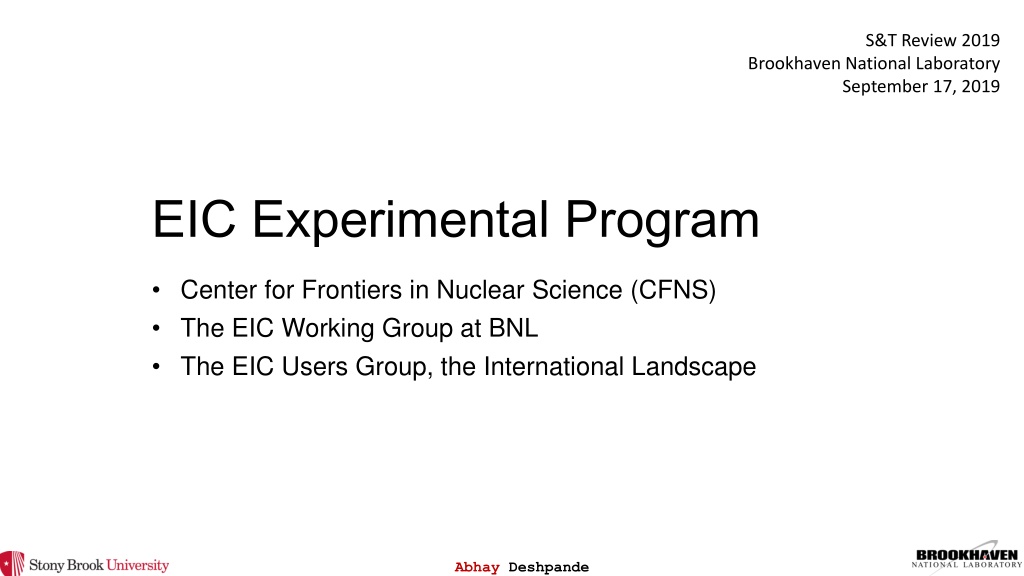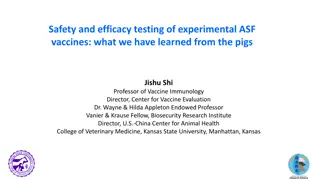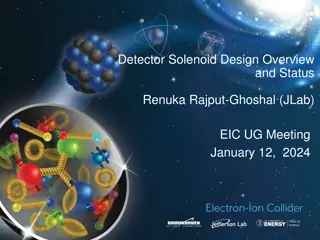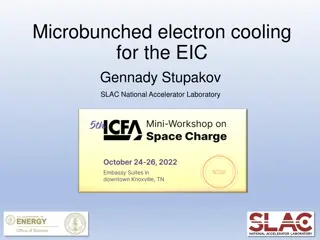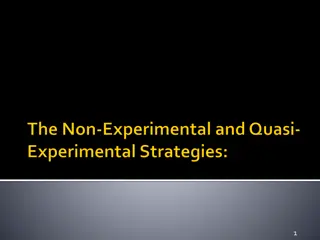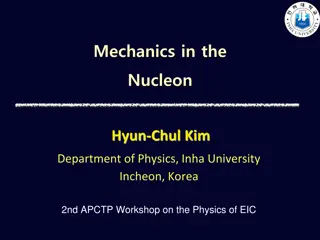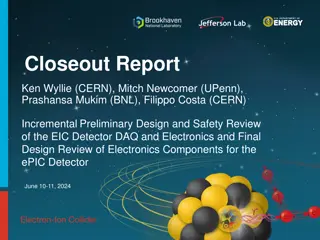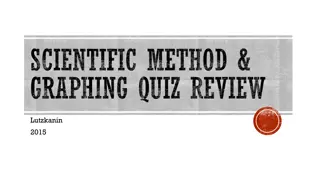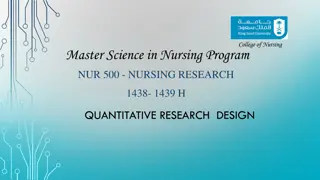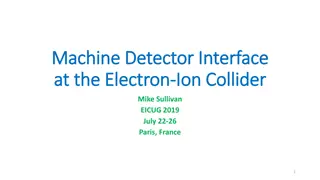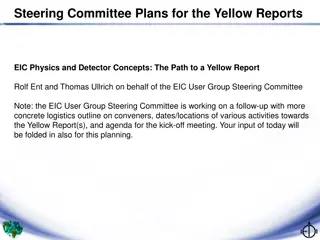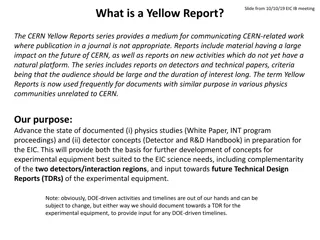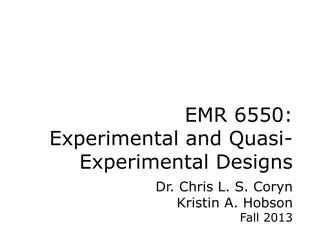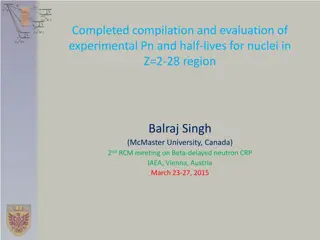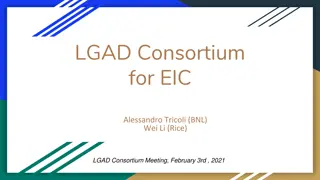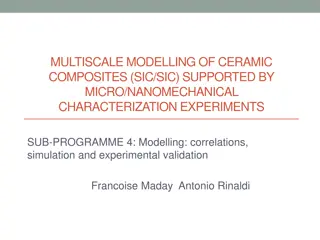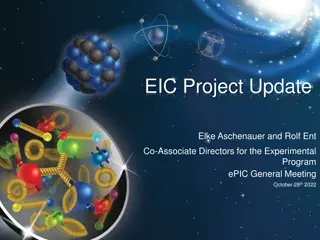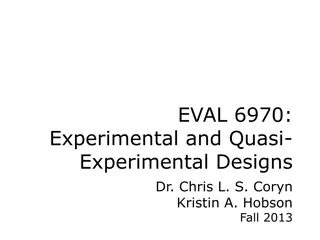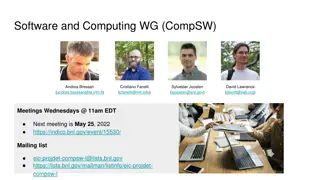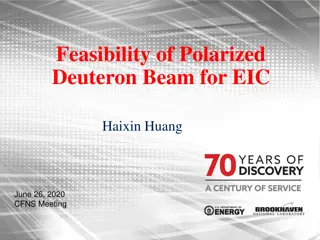EIC Experimental Program
Success of the EIC and its broad scientific scope depend on strong collaboration between theory and experimental communities, extending beyond traditional subfields. A vision for a dedicated Center at the US Electron Ion Collider is discussed, aimed at attracting and nurturing young scientists for future leadership. The Center for Frontiers in Nuclear Science at Brookhaven National Laboratory, supported by various institutions, plays a key role in facilitating this vision through governance and program advisory committees.
Download Presentation

Please find below an Image/Link to download the presentation.
The content on the website is provided AS IS for your information and personal use only. It may not be sold, licensed, or shared on other websites without obtaining consent from the author.If you encounter any issues during the download, it is possible that the publisher has removed the file from their server.
You are allowed to download the files provided on this website for personal or commercial use, subject to the condition that they are used lawfully. All files are the property of their respective owners.
The content on the website is provided AS IS for your information and personal use only. It may not be sold, licensed, or shared on other websites without obtaining consent from the author.
E N D
Presentation Transcript
S&T Review 2019 Brookhaven National Laboratory September 17, 2019 EIC Experimental Program Center for Frontiers in Nuclear Science (CFNS) The EIC Working Group at BNL The EIC Users Group, the International Landscape Abhay Deshpande
The background & motivation Success of the EIC, and its full exploitation depends on strong collaboration between theory and experimental communities, not only from other subfields of nuclear science (QCD community) but also beyond Need to continually explore avenues to deepen and broaden the science scope beyond the EIC White Paper. EIC with ~10 years of time scales creates a special type of need to attract, engage and support young scientists, who will be leaders of the programs at the EIC. An opportunity arose to attract non-DOE/NSF funding for supporting such an activities to help the EIC Users Community try to create a Center dedicated to the science of EIC to achieve the above two broad goals. 2 2/18/2025 EIC Experimental Program
Vision: A Center for all scientists interested in the US Electron Ion Collider A home for scientific discourse and help seed future collaborations attract & support young scientists https://www.stonybrook.edu/cfns/ Work with the EIC Users Group & the two Labs, optimally to help realize the US EIC Founded in September 2017 2/18/2025 EIC Experimental Program 3
The Center for Frontiers in Nuclear Science Support (Thanks!) The Simons Foundation ($5M) over 10 years & Stony Brook University/NY State ($3M) With strong backing from Stony Brook University & Brookhaven National Laboratory and their managements Two footprints: Stony Brook, Physics Building C-floor (Peter Paul Seminar Room, CFNS lounge, Visitor offices) + the labs (for detector R&D if necessary) in the basement: renovation funded by NY State funds BNL, Physics Building: Library now converted in to Seminar Room & 6 visitor cubicles : renovation funded by BNL/NPPD 4 2/18/2025 EIC Experimental Program
CFNS Governance International Advisory Committee: A formal annual review & advise R. Milner (MIT, Chair), A. Caldwell (MPI, Munich), L. Elouadrhiri (Jlab), B. Jacak (UCB/LBNL), X. Ji (Shanghai/Maryland), Y. Kovchegov (OSU), Z.-E. Meziani (ANL), W. Nazarewicz (MSU), P. Newman (Birmingham, UK), B. Pasquini (Pavia), F. Pilat (ORNL), J. Qiu (Jlab), G. Sterman (SBU), W. Vogelsang (Teubingen) Ex. Officio: B. Mueller (BNL), B. Surrow (Chair, EICUG-SC), and R. Yoshida (JLab) (to be replaced) Program Advisory Committee: Review of Workshop proposals M. Djehl (DESY, Chair), C. Keppel (Jlab), K. Kumar (U. Mass), P. Shanahan (MIT), F. Yuan (LBNL) Local Steering Committee: Help implement IAC and PAC recommendations T. Hemmick (SBU), D. Kharzeev (SBU/BNL), J. Kiryluk (SBU), T. Ullrich (BNL/Yale), R. Venugopalan (BNL, Co-Chair) & A. Deshpande (SBU, Chair) Scientific Coordinators: Logistical implementation with scientific outlook C. Gal (SBU), J. H. Lee (BNL), Administrative support: S. Delquaglio (SBU), M. Veri-Viteri (SBU) and R. Nieves (BNL) [All working for CFNS partially] Director: Smooth running of all activities and scientific initiatives A. Deshpande (SBU/BNL) 2/18/2025 EIC Experimental Program 5
CFNS Activities & Initiatives: An Overview SBU-BNL Joint CFNS Seminars : 2/month alternate between BNL and SBU CFNS Workshops and Adhoc Meetings CFNS Post doctoral fellows program: Post doctoral fellows coordinated and funded through BNL LDRDs at BNL Post doctoral fellows at SBU funded through Simons Funds Joint post doctoral fellows with remote institutions Supervised by CFNS associated scientists/faculty (BNL, SBU and some remote university faculty) Topics associated with the Electron Ion Collider, but also current research activities at RHIC and Jefferson Lab, CERN Visitor program for (mainly, but not exclusively) young scientists: short (< 7 days) and long (up to 3 months) term CFNS EIC QCD Summer Schools ~250 Scientists have visited the Center per year for the last 2 years 6 2/18/2025 EIC Experimental Program
CFNS Scientific Workshops 2018-2019-2020 7 2/18/2025 EIC Experimental Program
CFNS Post Doctoral Fellow (& Students) Program Activities supervised by CFNS associated faculty and scientists, reviewed by the IAC annually Post doctoral fellows supported at BNL on LDRDs ~ 9 Kolja Kauder, Alba Soto Ontoso, Abha Rajan, Kong Tu, Renaud Boussarie, James Daniel Brandenberg, Zhenyu Chen, Isaac Upsal Post doctoral fellows supported at SBU by Simons Foundation funds ~ 3 Barak Schmookler, Mriganka Mondal, Yuxiang Zhang, Esha Rolli Joint positions with remote institutions (CFNS pays 50% of the base salary + 5k for travel support) ~ 5 With PI s: B. Jacak (UCB), Z. Kang (UCLA), Y. Kovchegov (OSU), Silvia Dalla Torre (INFN/Trieste), C. Hyde (ODU), G. Sterman (YITP/SBU), K. Paschke (Uva) Graduate Student support (partial, incidental) for local scientists (BNL and SBU) with SBU graduate students 8 2/18/2025 EIC Experimental Program
August 1-9, 2019 at Stony Brook University Teachers: Z. Davoudi (Maryland), Y. Hatta (BNL), T. Horn (CUA), Z. Kang (UCLA), A. Kiselev (BNL), C. Lee (LANL), V. Morozov (Jlab), N. Sato (Jlab), M. Sievert (UIUC), A. Stasto (PSU), G. Sterman (SBU), J. Zhang (SBU) 25 selected students 5 countries (and 8 nationalities) + 5-7 local students and post docs attended 1st CFNS Summer School for Formal response from students recorded for future improvements. Over all Overwhelmingly positive. EIC Science EIC Experimental Program 2/18/2025 9
Other initiatives under consideration: CFNS Connections to International Institutions: Exchange visitor programs for the EIC under various stages of discussion: APCTP (South Korea), ICAS San Martin (Argentina), Institute of Physics, IIT s, NISER (India), exploring possibilities with Australia, Japan, open to other interests Edward Bouchet Initiative forQCD involving students and faculty from predominantly minority institutions in EIC related activities (~10 minority institutions + SBU, BNL, and MIT, Yale and U. Mass) Seeking funds from a Traineeship opportunity at the NSF Not aware of a similar opportunity at the DOE (input welcome) 10 2/18/2025 EIC Experimental Program
EIC Working Group at Will present the current status of the EIC WG, with comments on previous years where relevant at the bottom BNL Extensive input from Thomas Ullrich 1 1 2/18/2025 EIC Experimental Program
Charge to the BNL EIC Science Task Force Charge to the BNL EIC Science Task Force Charge to the BNL EIC Science Task Force Tom Ludlam 2009 1212.1701.v3 A. Accardi et al The purpose of this task force is to consolidate and focus a well-defined effort at BNL to develop and advance the science program for an Electron Ion Collider, both for e-A and e-p collisions. Based in the BNL Physics Department, the Task Force will work closely with the accelerator scientists in the C-A Department, and with the working groups of the global EIC Collaboration. Basic science questions and key measurements: Assemble a list of science questions that will drive the mission statement for an EIC, and a corresponding set of key measurements that will drive the machine requirements. A preliminary list should be completed in advance of the May EIC Collaboration meeting. Carry out simulations to demonstrate the feasibility and quality of the key measurements. An initial plan should be prepared for discussion at the May EIC Collaboration meeting. On a time scale of the fall of 2009 the Task Force should settle on a small set of key measurements to pursue in detail. Specific goals should be set for results that will be ready at the 2010 INT workshop. The above should include consideration of an initial medium-energy stage. Machine requirements: Identify requirements for an EIC machine to accomplish the key measurements established above, including a medium-energy stage. Detector design and development: Develop preliminary design concepts for possible EIC detectors based on the requirements related to the key measurements. Develop a common software framework for physics and detector simulations. Identify long-lead time (generic) R&D needs for an experimental detector. T. Ludlam 3/18/2009 The purpose of this task force is to consolidate and focus a well-defined effort at BNL to develop and advance the science program for an Electron Ion Collider, both for e-A and e-p collisions. Based in the BNL Physics Department, the Task Force will work closely with the accelerator scientists in the C-A Department, and with the working groups of the global EIC Collaboration. Basic science questions and key measurements: Assemble a list of science questions that will drive the mission statement for an EIC, and a corresponding set of key measurements that will drive the machine requirements. A preliminary list should be completed in advance of the May EIC Collaboration meeting. Carry out simulations to demonstrate the feasibility and quality of the key measurements. An initial plan should be prepared for discussion at the May EIC Collaboration meeting. On a time scale of the fall of 2009 the Task Force should settle on a small set of key measurements to pursue in detail. Specific goals should be set for results that will be ready at the 2010 INT workshop. The above should include consideration of an initial medium-energy stage. Machine requirements: Identify requirements for an EIC machine to accomplish the key measurements established above, including a medium-energy stage. Detector design and development: Develop preliminary design concepts for possible EIC detectors based on the requirements related to the key measurements. Develop a common software framework for physics and detector simulations. Identify long-lead time (generic) R&D needs for an experimental detector. Charge to the BNL EIC Science Task Force The purpose of this task force is to consolidate and focus a well-defined effort at BNL to develop and advance the science program for an Electron Ion Collider, both for e-A and e-p collisions. Based in the BNL Physics Department, the Task Force will work closely with the accelerator scientists in the C-A Department, and with the working groups of the global EIC Collaboration. Basic science questions and key measurements: Assemble a list of science questions that will drive the mission statement for an EIC, and a corresponding set of key measurements that will drive the machine requirements. A preliminary list should be completed in advance of the May EIC Collaboration meeting. Carry out simulations to demonstrate the feasibility and quality of the key measurements. An initial plan should be prepared for discussion at the May EIC Collaboration meeting. On a time scale of the fall of 2009 the Task Force should settle on a small set of key measurements to pursue in detail. Specific goals should be set for results that will be ready at the 2010 INT workshop. The above should include consideration of an initial medium-energy stage. Machine requirements: Identify requirements for an EIC machine to accomplish the key measurements established above, including a medium-energy stage. Detector design and development: Develop preliminary design concepts for possible EIC detectors based on the requirements related to the key measurements. Develop a common software framework for physics and detector simulations. Identify long-lead time (generic) R&D needs for an experimental detector. The purpose of this task force is to consolidate and focus a well-defined effort at BNL to develop and advance the science program for an Electron Ion Collider, both for e-A and e-p collisions. Based in the BNL Physics Department, the Task Force will work closely with the accelerator scientists in the C-A Department, and with the working groups of the global EIC Collaboration. Basic science questions and key measurements: Assemble a list of science questions that will drive the mission statement for an EIC, and a corresponding set of key measurements that will drive the machine requirements. A preliminary list should be completed in advance of the May EIC Collaboration meeting. Carry out simulations to demonstrate the feasibility and quality of the key measurements. An initial plan should be prepared for discussion at the May EIC Collaboration meeting. On a time scale of the fall of 2009 the Task Force should settle on a small set of key measurements to pursue in detail. Specific goals should be set for results that will be ready at the 2010 INT workshop. The above should include consideration of an initial medium-energy stage. Machine requirements: Identify requirements for an EIC machine to accomplish the key measurements established above, including a medium-energy stage. Detector design and development: Develop preliminary design concepts for possible EIC detectors based on the requirements related to the key measurements. Develop a common software framework for physics and detector simulations. EIC Task Force (now renamed a Working Group has played a key role in developing the science case, defining the machine parameters & influencing the detector design ideas Working Group) 12 2/18/2025 Identify long-lead time (generic) R&D needs for an experimental detector. EIC Experimental Program T. Ludlam 3/18/2009 T. Ludlam 3/18/2009 T. Ludlam 3/18/2009
Aim: Provide scientific and technical guidance for realizing the EIC-at-BNL working with the CAD, the EIC Users Group (and recently in a coordinated way with the CFNS) Approach: Hired extremely talented scientists with experience in DIS to drive the physics at the EIC, established collaborations with the best theorists, conferences, workshops, visitors Level of Support: Current level of support (B. Page, S. Fazio, A. Kiselev) + some IT support & travel, visitors, and funds to take on graduate students on selected topics Physics & technical thrust: Broaden the physics scope of the EIC (Jets, GPDs, Imaging, Correlations) Actively support EIC IR design effort for the pre-CDR, Detector R&D and EIC software 13 2/18/2025 EIC Experimental Program
Publications (FY19) E.C. Aschenauer, S. Fazio, J.H. Lee, H. Mantysaari, B.S. Page, B. Schenke, T. Ullrich, R. Venugopalan, P. Zurita, The Electron-Ion Collider: Assessing the Energy Dependence of Key Measurements , Rept. Prog. Phys. 82 (2019) no.2, 024301 Measuring the Weizs cker-Williams distribution of linearly polarized gluons at an electron-ion collider through dijet azimuthal asymmetries, Adrian Dumitru, Vladimir Skokov, Thomas Ullrich, Phys. Rev. C99 (2019), 015204 S. Fazio, Nuclear Parton Distributions at the future Electron-Ion Collider , PoS DIS2017 (2018) 084 B.Azmoun et al, Design Studies for a TPC Readout Plane using Zigzag Patterns with Multistage GEM Detectors , IEEE Trans.Nucl.Sci. 65 (2018) no.7, 1416- 1423. ~10 publications in FY17-FY19 led by the members of the EIC Task Force 14 2/18/2025 EIC Experimental Program
The EIC Users Group and International Perspective 15 2/18/2025 EIC Experimental Program
EIC detector R&D program URL: https://wiki.bnl.gov/conferences/index.php/EIC_R%25D Started in 2011 at BNL, with Jlab and DOE office of NP, funded by DOE through RHIC operations funds Non-site-specific and open to international collaborators R&D Program In Numbers Number of Proposals per FY Typical 10-11 projects supported Attempt to merge projects in consortia when related Participation: 46 institutions (13 non-US) 6 Natl. Labs 187 participants Since 2016 budget flat ~$1M Requested funds typically exceed available funds by factor 1.5-2.5 background studies, TRD, DAQ/Streaming Readout, and R&D for Roman Pots 20 LRP 18 17 10-11 proposals supported at a time, 46 institutions (13 non-US), 6 national labs, 187 participants Funding requests typically ~3 times the available funding Current topics include: Calorimetry, Tracking/PID, Si Tracking, e+A simulations, software development, 15 13 13 12 11 10 7 6 5 0 2012 2013 2014 2015 2016 2017 2018 2019 Funding per FY $1,600,000 $1,400,000 $1,200,000 $1,000,000 $800,000 $600,000 N.B.: Generic RHIC detector funding was $4M in 2018$ $400,000 $200,000 $0 2011 2012 2013 2014 2015 2016 2017 2018 2019 ! 2 16 2/18/2025 EIC Experimental Program
New: The EIC Users Group: EICUG.ORG Center for Frontiers in Nuclear Science (at Stony Brook/BNL) EIC2 at Jefferson Laboratory Formally established in 2016 890+ Ph.D. Members from 30 countries, 189 institutions EICUG Structures in place and active. (BNL representative) EIC UG Steering Committee (T. Ullrich) EIC UG Institutional Board (R. Venugopalan, A. Deshpande) EIC UG Speaker s Committee (L. Ruan) Election & Nomination Committee (A. Deshpande) Task forces on: -- Beam polarimetry (E. Aschenauer) -- IR/Luminosity measurement (A. Kiselev, C.Montag) -- Software (T. Wenaus) Annual meetings: Stony Brook (2014), Berkeley (2015), ANL (2016), Trieste (2017), CAU (2018), Paris (2019), FIU (2020), Warsaw (2021) 17 2/18/2025 EIC Experimental Program
EIC UG and International Perspective Steering Committee: (has elected European and Asian representative) Bernd Surrow (Chair, Temple), Richard Milner (Vice-Chair, MIT), John Arrington (ANL), Ernst Sichtermann (LBNL), Marco Radici (INFN), Daniel Boer(Groningen, Europe), Yuji Goto (RIKEN, Asia), Thomas Ullrich (BNL) & Rolf Ent (JLab) Institutional Board: (already has non-US member) Christine Aidala (U. of Michigan, Chair), Andreas Bressan (INFN, Vice-Chair) Conference and Talks committee: (already has non-US member) Ralf Seidl (RIKEN), Carlos Munoz Camacho (Orsay), Barbara Pasquini (INFN Pavia), Yulia Ferletova (JLab), Lijuan Ruan (BNL) Election & Nomination Committee: (already has non-US member) Abhay Deshpande (SBU/BNL), Christian Weiss (Jlab), Paul Newman (Birmingham) + 2 TBD 18 2/18/2025 EIC Experimental Program
Summary The Center for Frontiers in Nuclear Science is now an emergence strong center of QCD related to EIC; Ready and is already to working the EICUG, the Labs to seed collaborations, expand the EIC science, working with its young scientists and visitors. At BNL the EIC Working Group continues to be an extremely effective group to focus on details of the EIC science and its growth. Has strong influence on the EIC design parameters including machine, IR and detector. The Users Group is maturing fast, and will play a critical role working with the Labs (and the DOE) to attract national and international collaborators. BNL is playing a strong role in the UG. Fast and bold moves of the EIC through the CD process are being anticipated, eagerly with excitement, enthusiasm and gratitude. 19 2/18/2025 EIC Experimental Program
